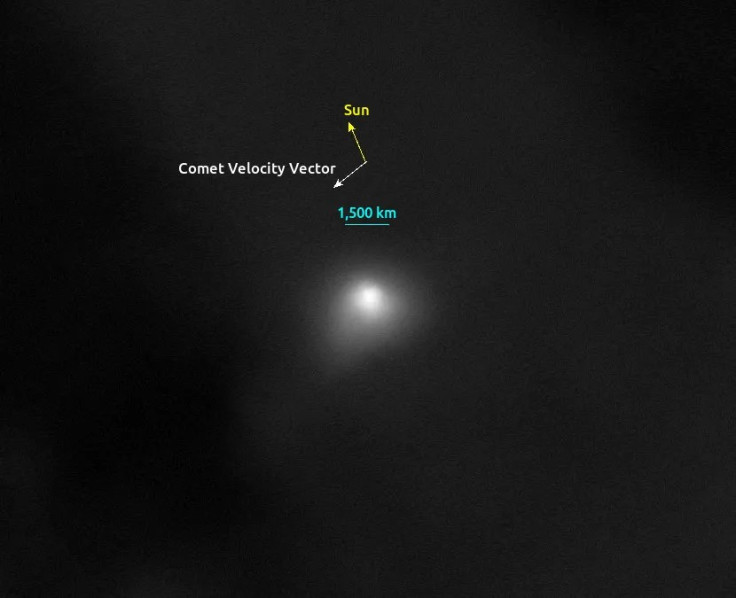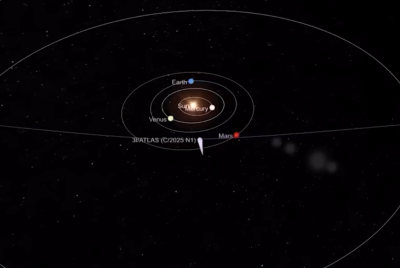MAVEN Captures Shocking Deuterium Ratios: What Comet 3I/ATLAS Means For Earth
NASA's Mars fleet captures interstellar comet 3I/ATLAS. See how shocking new deuterium data could rewrite the history of Earth's water.

It is a rare event for the solar system to receive a visitor from the vast, lonely void of interstellar space, and even rarer to catch it on camera. Yet, at the beginning of October, the cosmic stage was set for exactly such an encounter.
Three of NASA's seasoned Mars explorers turned their gaze away from the Red Planet to capture observations of 3I/ATLAS, marking only the third time an interstellar object has been discovered within our celestial neighbourhood.
While the comet is not scheduled to make its closest approach to Earth until Friday, December 19th, the Martian flotilla has already secured a front-row seat. The Mars Reconnaissance Orbiter (MRO) managed to snap a high-resolution close-up, while the MAVEN orbiter utilised ultraviolet imaging to analyse the object's chemistry.
Even the Perseverance rover, grounded on the dusty surface of Mars, managed to spot the traveller. These combined datasets are invaluable; imagery from MRO will allow scientists to refine estimates of the comet's size, while MAVEN's unique observations are crucial for determining how much water vapour releases as the Sun warms the icy intruder.

The MRO Orbiter Captures a Close-Up of 3I/ATLAS
On October 2nd, MRO achieved a significant imaging feat by observing 3I/ATLAS from a distance of 19 million miles (30 million kilometres). This specific observation represents one of the closest views that any spacecraft or Earth-based telescope is expected to achieve during the comet's journey through the inner solar system.
To make this possible, the orbiter's team had to pivot the massive spacecraft, pointing its HiRISE camera (High Resolution Imaging Science Experiment)—usually fixed on the Martian surface—toward the depths of space. This rotational technique was previously employed in 2014 when HiRISE joined MAVEN in studying the comet Siding Spring.
The resulting images, captured at a scale of roughly 19 miles (30 kilometres) per pixel, reveal 3I/ATLAS not as a solid rock, but as a pixelated white ball. This sphere is actually the coma, a nebulous cloud of dust and ice shed by the nucleus as it follows its trajectory past Mars.
'Observations of interstellar objects are still rare enough that we learn something new on every occasion', said Shane Byrne, HiRISE principal investigator at the University of Arizona in Tucson. 'We're fortunate that 3I/ATLAS passed this close to Mars'.
By analysing the HiRISE data further, researchers hope to estimate the dimensions of the comet's nucleus, its central core of ice and dust. Additionally, deep study of the pixelated imagery may divulge the size and colour of the particles swirling within the coma.
'One of MRO's biggest contributions to NASA's work on Mars has been watching surface phenomena that only HiRISE can see', said MRO's project scientist Leslie Tamppari of NASA's Jet Propulsion Laboratory in Southern California. 'This is one of those occasions where we get to study a passing space object as well'.

MAVEN Decodes the Chemistry of 3I/ATLAS
While MRO focused on visual structure, the MAVEN (Mars Atmosphere and Volatile EvolutioN) orbiter spent 10 days, starting September 27th, analysing the comet's composition. Using its Imaging Ultraviolet Spectrograph (IUVS), MAVEN captured 3I/ATLAS in two distinct modes.
Initially, the instrument took multiple images across several wavelengths, a process similar to applying different filters to a standard camera lens. Following this, it snapped high-resolution UV images specifically designed to identify hydrogen emissions radiating from the comet.
'The images MAVEN captured truly are incredible', said Shannon Curry, MAVEN's principal investigator and research scientist at the Laboratory for Atmospheric and Space Physics (LASP) at the University of Colorado Boulder. 'The detections we are seeing are significant, and we have only scraped the surface of our analysis'.
The scientific implications of this data are profound and directly impact our understanding of Earth's own history. The IUVS readings offer a critical measurement: an estimated upper limit of the comet's ratio of deuterium—a heavy isotope of hydrogen—to regular hydrogen. This ratio acts as an immutable 'chemical fingerprint', serving as a vital tracer of the comet's origin.
Deuterium contains a neutron that regular hydrogen lacks, making it heavier; by measuring the abundance of this 'heavy water' versus normal water in 3I/ATLAS, scientists can determine if the water in this interstellar visitor matches the water found in Earth's oceans.
The results could be pivotal for one of planetary science's oldest debates: did Earth's water come from home-grown asteroids, or was it delivered by comets from deep space?
If 3I/ATLAS possesses a deuterium-to-hydrogen ratio similar to Earth's, it would be a shocking revelation, suggesting that interstellar comets—rather than just local solar system objects—could have seeded our planet with the ingredients for life billions of years ago. Conversely, a significantly higher ratio would suggest our oceans are unique to our local solar family.
When 3I/ATLAS was at its nearest point to Mars, the team utilised the most sensitive channels of the IUVS to map various atoms and molecules within the coma, including hydroxyl.
'There was a lot of adrenaline when we saw what we'd captured', said MAVEN's deputy principal investigator, Justin Deighan, a LASP scientist and the lead on the mission's comet 3I/ATLAS observations. 'Every measurement we make of this comet helps to open up a new understanding of interstellar objects'.
Perseverance Spots 3I/ATLAS from the Surface
Far below the orbital dance of MRO and MAVEN, NASA's Perseverance rover provided a different perspective from the Martian ground. On October 4th, the comet appeared to the rover's Mastcam-Z camera. Because the object was so dim, the camera required an exceptionally long exposure.
Unlike powerful telescopes that can track objects as they move across the sky, Mastcam-Z is fixed in place during these long exposures. As a result, the image features star trails that appear as streaks in the sky, with the comet itself visible as a faint smudge—a subtle but technically impressive detection.
The management of these missions is a collaborative triumph. A division of Caltech in Pasadena, California, JPL manages MRO for NASA's Science Mission Directorate in Washington as part of NASA's Mars Exploration Program portfolio. The University of Arizona in Tucson operates MRO's HiRISE, which was built by BAE Systems in Boulder, Colorado, while Lockheed Martin Space in Denver built the orbiter itself.
The MAVEN mission is led by the Laboratory for Atmospheric and Space Physics at the University of Colorado Boulder and managed by NASA's Goddard Space Flight Center in Greenbelt, Maryland.
As 3I/ATLAS continues its silent voyage back into the void, the data gathered by our Martian sentinels remains behind, potentially holding the key to Earth's watery origins. The coming months promise to be a time of revelation as scientists decode these interstellar signals to determine if our oceans share a lineage with this distant wanderer.
Keep your eyes on the skies for the comet's closest approach to Earth this December 19th, and subscribe to our newsletter to be the first to know if the upcoming analysis confirms that life on Earth was seeded by visitors from the deep universe.
© Copyright IBTimes 2025. All rights reserved.





















